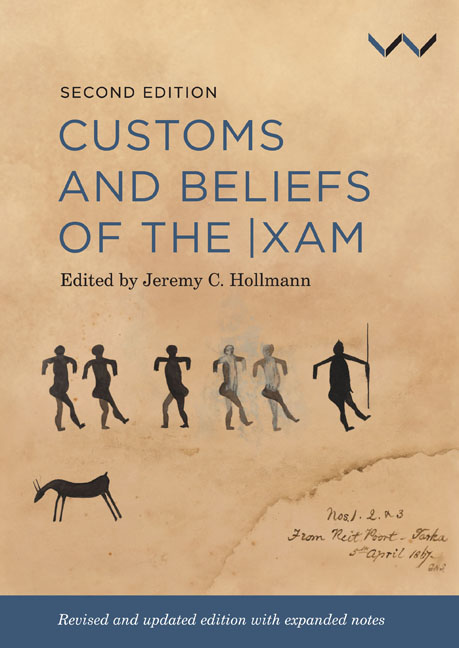Book contents
- Frontmatter
- Dedication
- Contents
- Acknowledgements
- Foreword To The Second Edition
- Foreword To The First Edition
- Introduction
- Contributors
- The |Xam Language
- The People In The Notebooks
- Part 1 Baboons
- Part 2 The Lion
- Part 3 Game Animals
- Part 4 Omens, Windmaking, Clouds
- Part 5 Rain
- Part 6 Rainmaking
- Part 7 Sorcerers
- Part 8 More About Sorcerers and Charms
- Part 9 Special Speech of Animals and Moon
- Appendix 1 |Xam Grammar
- Appendix 2 Summary of The Narratives
- References
- Index
Part 1 - Baboons
Published online by Cambridge University Press: 24 November 2023
- Frontmatter
- Dedication
- Contents
- Acknowledgements
- Foreword To The Second Edition
- Foreword To The First Edition
- Introduction
- Contributors
- The |Xam Language
- The People In The Notebooks
- Part 1 Baboons
- Part 2 The Lion
- Part 3 Game Animals
- Part 4 Omens, Windmaking, Clouds
- Part 5 Rain
- Part 6 Rainmaking
- Part 7 Sorcerers
- Part 8 More About Sorcerers and Charms
- Part 9 Special Speech of Animals and Moon
- Appendix 1 |Xam Grammar
- Appendix 2 Summary of The Narratives
- References
- Index
Summary
Baboons (|hu|hu, Bleek 1956: 291; scientific name Papio ursinus) are not like other things. They talk to each other and to people. They were people in the ‘past’ and in the ‘present’. This is reflected in the stories about baboons: while one particular narrative will focus on baboons as the animals they are today, another refers back to a time when baboons were people. Their personhood seems to persist between both worlds, as Dorothea Bleek points out in her introduction to Part 1:
This number shows the Bushman's beliefs concerning baboons and his methods of dealing with them. The dividing line between mankind and the animal world is never very deep with the little hunters, it is therefore not surprising that they attribute to baboons many human characteristics. In doing so they give us insight into their own frame of mind, their respect for a girl's belongings, their belief in the sensations of the body foretelling danger, and in the body turning into clouds after death.
(Bleek 1931: 179)The |xɑm called baboons the ‘people that sit upon (their) heels’ (Bleek & Lloyd 1911: 17; A2.1.086, L.VIII.11: 6978–7094) and said that their foreheads resemble overhanging cliffs (A2.1.073, L.V.24: 5931 rev.). They look like people, they have wives, and they speak and sing as |xɑm people do (Narratives 1.1, 1.2, 1.4 and 1.8). Baboons have agency and emotions (sadness, grief and, seemingly, compassion). Baboons use medicines too – they keep a stick of a powerful medicine called sˀoː-|ã(also spelled ʃo-|õä) inside their mouth. This protects them against feeling pain and warns them about the approach of danger; |xɑm people remove this stick from a baboon they have killed. They use baboons’ hair as a ‘charm’ against illness.
Although baboons may be like people, they are also ‘strangers’ – ‘people who are different’ (A2.1.086, L.VIII.11: 7077–7078). The reasons for their difference go back to the time of the Early Race when all the animals lived together, gathering and hunting much as the |xɑm did (Hewitt 1986: 105; Part 9).
Baboons and the Early Race
Baboons existed before humans and bequeathed some of their culture to people, especially the song or dance called ǂgebbi-gu (Narratives 1.8–1.10). Like all the animals at this time, baboons were considered to be people but, by |xɑm standards, the behaviour of baboons was shocking. They were the ‘stereotype of undesirable in-laws’ (Hewitt 1986: 109).
- Type
- Chapter
- Information
- Customs and Beliefs of the |xam , pp. 31 - 66Publisher: Wits University PressPrint publication year: 2022



